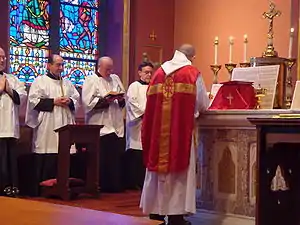Latin Mass
A Latin Mass is a Roman Catholic Mass celebrated in Ecclesiastical Latin. While the liturgy is Latin, any sermon may be in the local vernacular, as permitted since the Council of Tours 813.

Tridentine Mass in Latin
The term "Latin Mass" is frequently used to denote the Tridentine Mass, that is, the Roman Rite liturgy of the Mass celebrated in Latin and in accordance with the successive editions of the Roman Missal published between 1570 and 1962.
In most countries, the Tridentine Mass was celebrated only in Latin. However, there are exceptions. In early seventeenth century China, Jesuit missionaries secured permission from Pope Paul V to celebrate the Catholic Mass in Chinese, part of an effort to adapt their work to Chinese cultural norms and conditions.[1] In Dalmatia and parts of Istria, the liturgy was celebrated in Church Slavonic, and authorization for use of this language was extended to some other Slavic regions between 1886 and 1935.[2][3] There, "Tridentine Mass" was not synonymous with "Latin Mass".
A further distancing between the concepts of "Tridentine Mass" and "Latin Mass" was brought about by the 1964 Instruction on implementing the Constitution on Sacred Liturgy of the Second Vatican Council, which laid down that "normally the epistle and gospel from the Mass of the day shall be read in the vernacular". Episcopal conferences were to decide, with the consent of the Holy See, what other parts, if any, of the Mass were to be celebrated in the vernacular.[4] Permissions were thus granted from 1967 onwards to celebrate most of the Tridentine Mass in vernacular languages, including the Canon.
Roman Rite Mass in Latin
Neither the Second Vatican Council nor the subsequent revision of the Roman Missal abolished Latin as the liturgical language of the Roman Rite: the official text of the Roman Missal, on which translations into vernacular languages are to be based, continues to be in Latin, and Latin can still be used in the celebration.[5] The term "Latin Mass" is sometimes applied to such celebrations, which in some places are part of the normal Sunday schedule.
Other forms of Mass in Latin
Historically speaking, "Latin Mass" can be applied also to the various forms of Pre-Tridentine Mass from about the year 190 of Pope Victor, when the Church in Rome changed from Greek to Latin.[6]
Latin liturgical rites other than the Roman Rite have used Latin, and in some cases continue to do so. These include the Ambrosian Rite and the Mozarabic Rite. Some priests and communities continue to use non-Roman-Rite liturgies that have been generally abandoned, such as the Carmelite Rite and the Dominican Rite, celebrating them in Latin. Celebration in Latin of such rites is sometimes referred to as "Latin Mass".[7]
Other uses
A Traditionalist Catholic periodical in the United States is entitled The Latin Mass, the Journal of Catholic Culture and Tradition.
Various editions of the Anglican Book of Common Prayer have been translated into Latin: for example, for use in the Universities of Oxford and Cambridge (Liber Precum Publicarum of Walther Haddon, 1560). The Church of the Advent of Christ the King, an Anglo-Catholic parish in San Francisco, regularly celebrates Mass according to the 1979 Prayer Book of its province, the Episcopal Church, in Latin.
References
- Hsia, Ronnie Po-Chia (1998). The World of Catholic Renewal, 1540-1770. New York: Cambridge University Press. pp. 210–211. ISBN 0521445965.
- Krmpotic, M.D. (1908). "Dalmatia". Catholic encyclopedia. Retrieved 19 June 2014.
The right to use the Glagolitic [sic] language at Mass with the Roman Rite has prevailed for many centuries in all the south-western Balkan countries, and has been sanctioned by long practice and by many popes.
- Japundžić, Marko (1997). "The Croatian Glagolitic Heritage". Croatian Academy of America. Retrieved June 19, 2014.
In 1886 it arrived to the Principality of Montenegro, followed by the Kingdom of Serbia in 1914, and the Republic of Czechoslovakia in 1920, but only for feast days of the main patron saints. The 1935 concordat with the Kingdom of Yugoslavia anticipated the introduction of the Slavic liturgy for all Croatian regions and throughout the entire state.
- "Inter Oecumenici, Sacred Congregation of Rites". 2007. Retrieved 2008-03-25.
- Redemptionis sacramentum, Rome, IT: The Vatican, 112,
Except in the case of celebrations of the Mass that are scheduled by the ecclesiastical authorities to take place in the language of the people, Priests are always and everywhere permitted to celebrate Mass in Latin
. - Spencer, The Rev. Sidney (2013-03-05), "Christianity", Britannica (encyclopaedia) (online ed.), retrieved 2014-01-27.
- Messa latina: la santa Messa in latino secondo il rito Ambrosiano Antico [Latin Mass: Holy Mass in Latin in accordance with the Ancient Ambrosian Rite] (in Italian), Milan, IT: Parish of Santa Maria di Caravaggio.